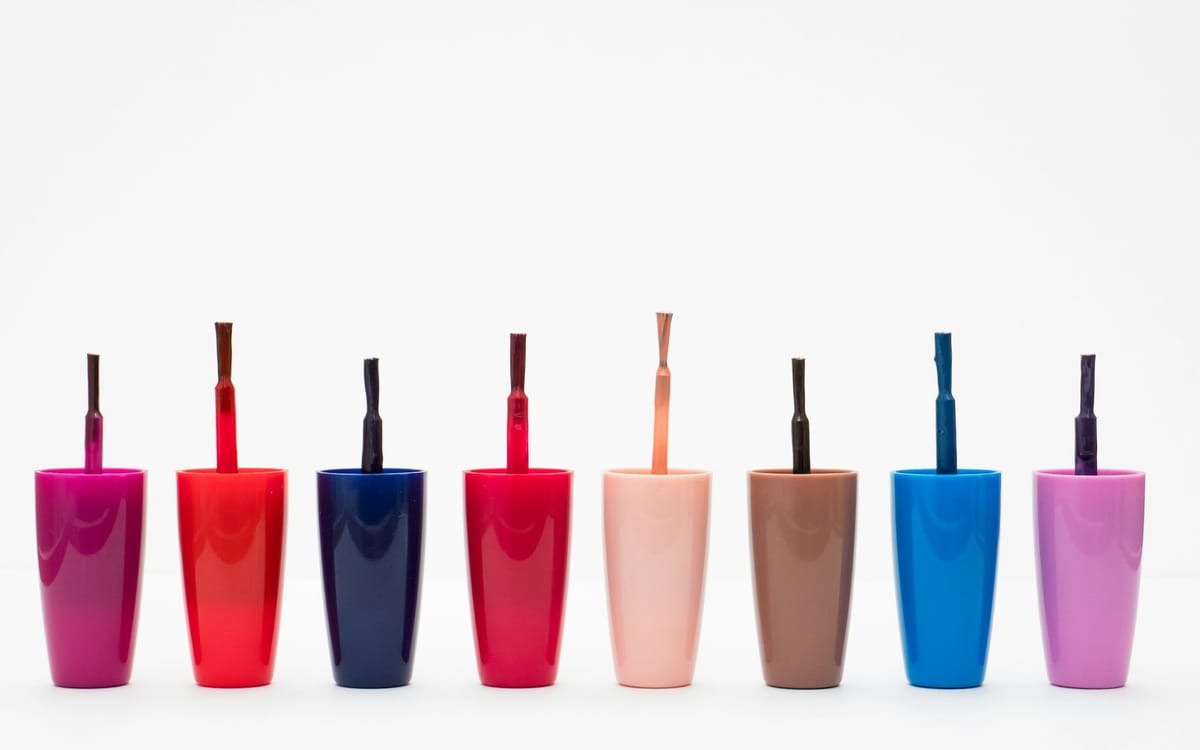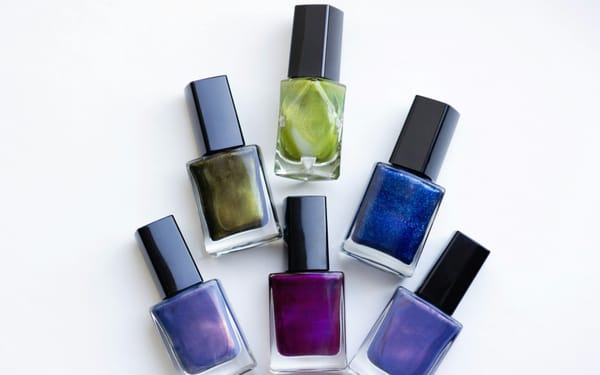The Science Behind Halal Breathable Nail Polish: How It Really Works

Bottom Line: Breathable nail polish uses special polymers that create microscopic pores in the dried polish, allowing water and oxygen molecules to pass through while maintaining beautiful color and shine. This revolutionary chemistry lets Muslim women perform wudu without removing their manicure.
Gone are the days when Muslim women had to choose between beautiful nails and their faith. Thanks to groundbreaking polymer science, breathable nail polish has transformed the beauty industry, making it possible to maintain manicures while staying true to Islamic practices.
But how exactly does this revolutionary polish work? Let's dive into the fascinating science that makes it all possible.
What Makes Traditional Polish Different from Breathable Polish?
Traditional Nail Polish: The Airtight Seal
Regular nail polish creates what's essentially a plastic barrier on your nails. The main ingredient, nitrocellulose, forms when plant fibers are treated with nitric acid. When you apply polish, solvents evaporate and leave behind tightly packed polymer chains.
Think of it like shrink wrap - completely waterproof and airtight. That's why your nails can turn yellow or become brittle after wearing regular polish for weeks.
Breathable Polish: The Game-Changer
Breathable polish takes a completely different approach. Instead of creating an impermeable barrier, it forms a semi-permeable membrane with microscopic openings.
The secret lies in specialized polymers, many borrowed from contact lens technology. These create tiny pathways - invisible to the naked eye - that allow water molecules and oxygen to diffuse through while keeping the color locked in place.
The Contact Lens Connection: Borrowed Technology
Here's where it gets really interesting - many halal nail polish brands use the same polymers found in soft contact lenses.
Poly(HEMA): The Star Ingredient
Poly-hydroxyethyl methacrylate, or Poly(HEMA), is a hydrophilic (water-loving) polymer that can absorb moisture while remaining oxygen-permeable. Inglot's pioneering O2M line uses a polymer called KS-02, which is essentially this contact lens material adapted for nails.
When you think about it, it makes perfect sense. Contact lenses need to let oxygen reach your cornea while keeping bacteria out. Breathable polish needs to let water reach your nail while keeping pigments locked in.
How Water Actually Gets Through
The process isn't as simple as liquid water flowing through tiny holes. Instead, it works through molecular diffusion - a process that happens at the tiniest level.
The Porous Network
Under an electron microscope, breathable polish reveals a spongy structure with pores ranging from 10 to 70 micrometers in diameter. For perspective, that's about the thickness of a human hair, but these openings create pathways throughout the entire polish film.
Water Vapor vs. Liquid Water
Most breathable polishes allow water vapor to permeate gradually. When you perform wudu, moisture slowly migrates through the polymer network to reach your nail surface. Some advanced formulas, like those from Tuesday in Love, claim their polish allows liquid water to penetrate without any rubbing required.
The key is that water molecules (only 0.27 nanometers in size) are tiny enough to navigate through the polymer's free spaces, while larger pigment particles (hundreds of nanometers) stay trapped in the film.
Key Ingredients That Make It Work
Specialized Film Formers
Instead of relying solely on nitrocellulose, breathable polishes incorporate:
- VP/VA copolymer: A water-friendly polymer that introduces hydrophilic channels
- Cellulose Acetate Butyrate (CAB): Forms tougher films with more permeable microstructures
- Bio-based silk proteins: Create net-like matrices for enhanced breathability
Modified Resin Systems
Traditional polishes often contain formaldehyde-based resins that create dense, impermeable films. Breathable formulas use alternatives like Adipic Acid/Neopentyl Glycol/Trimellitic Anhydride Copolymer, which provides adhesion and gloss while leaving microscopic gaps.
Smart Plasticizers
Even the plasticizers (ingredients that keep polish flexible) are chosen specifically. Citrate esters can actually increase water vapor permeability by pushing polymer chains slightly apart, creating more pathways for moisture.
The Testing: How We Know It Really Works
Brands don't just claim their polish is breathable - they prove it through rigorous testing.
Laboratory Methods
Professional testing involves measuring Water Vapor Transmission Rate (WVTR) using standards like ASTM D1653. Polish films are mounted between chambers, and instruments measure how much water vapor passes through over time.
For oxygen permeability, similar setups measure oxygen transmission using methods adapted from food packaging industries.
The Coffee Filter Test
While not scientifically precise, many consumers use the simple coffee filter test: paint a filter with polish, let it dry, then drop water on one side to see if it seeps through. Tuesday in Love and other brands have earned halal certifications based on independent lab testing that confirms water can reach the nail surface.
Performance: Does Breathable Mean Sacrificing Quality?
Surprisingly, breathable polishes often outperform traditional formulas in several ways:
Durability
Because natural nail oils can escape through the porous film instead of accumulating and breaking the bond, many users report their breathable manicures last longer - typically 5-7 days without chipping.
Nail Health
Users consistently report less nail yellowing, brittleness, and peeling after extended wear. The ability for moisture and oxygen to reach the nail bed prevents many common problems associated with regular polish.
Application and Finish
Modern breathable formulas match traditional polish in terms of:
- Gloss: Microscopic pores don't affect the smooth, shiny finish
- Color payoff: Pigments are just as vibrant and often provide one-coat coverage
- Drying time: Most dry within 2-3 minutes per coat, similar to regular polish
The Latest Innovations: What's Next?
Breathable Gel Polish
The holy grail of halal nail polish just arrived with L'Atelier Green's revolutionary breathable gel system. By removing HEMA monomer and using plant-based polymers, they've created a gel that cures under LED light while maintaining permeability.
Bio-Based Polymers
Skinicer's Oxyperm uses synthetic spider-silk protein to create a breathable film. This vegan biopolymer forms a net-like structure that's both water-repellent and permeable - showcasing how biotechnology is pushing the boundaries of cosmetic chemistry.
Enhanced Testing Standards
As the market grows, brands are moving beyond simple "breathable" claims to provide specific permeability data. Expect to see more detailed certifications and standardized testing methods in the coming years, Inshallah.
Choosing the Right Breathable Polish
When shopping for breathable polish, look for:
- Third-party certification: Brands like Tuesday in Love test every batch independently
- Clear ingredient lists: Quality brands are transparent about their polymer technology
- Application guidelines: Most work best with thin, two-coat applications
- Matching base and top coats: Using the brand's complete system ensures permeability throughout
The Science Speaks for Itself
What started as an solution for Muslim women's religious needs has evolved into a breakthrough in cosmetic chemistry. By engineering polymers at the molecular level, scientists have created polishes that are both beautiful and permeable.
The technology borrowed from medical applications proves that innovation often comes from addressing specific needs. Today, non-Muslim consumers increasingly choose breathable formulas for the nail health benefits alone.
Whether you wear breathable polish for religious reasons or simply want healthier nails, you're benefiting from some seriously impressive chemistry. The next time you apply your favorite halal beauty products, remember - there's real science making that "breathable" claim possible.
Looking for specific brand recommendations? Check out our comprehensive guide to the best halal nail polish brands to find your perfect match.





